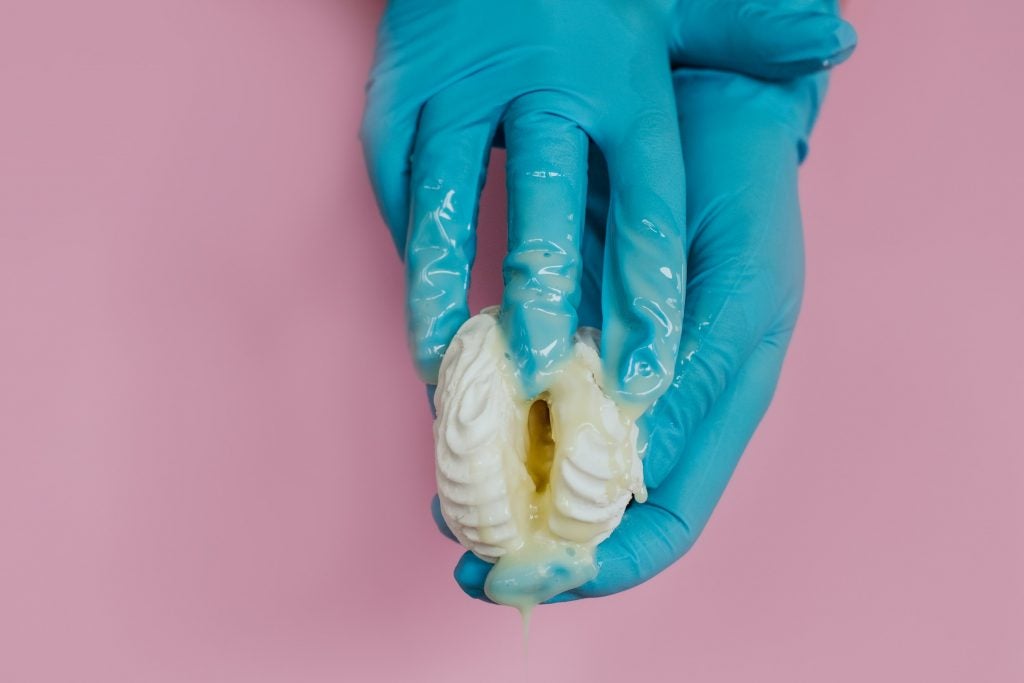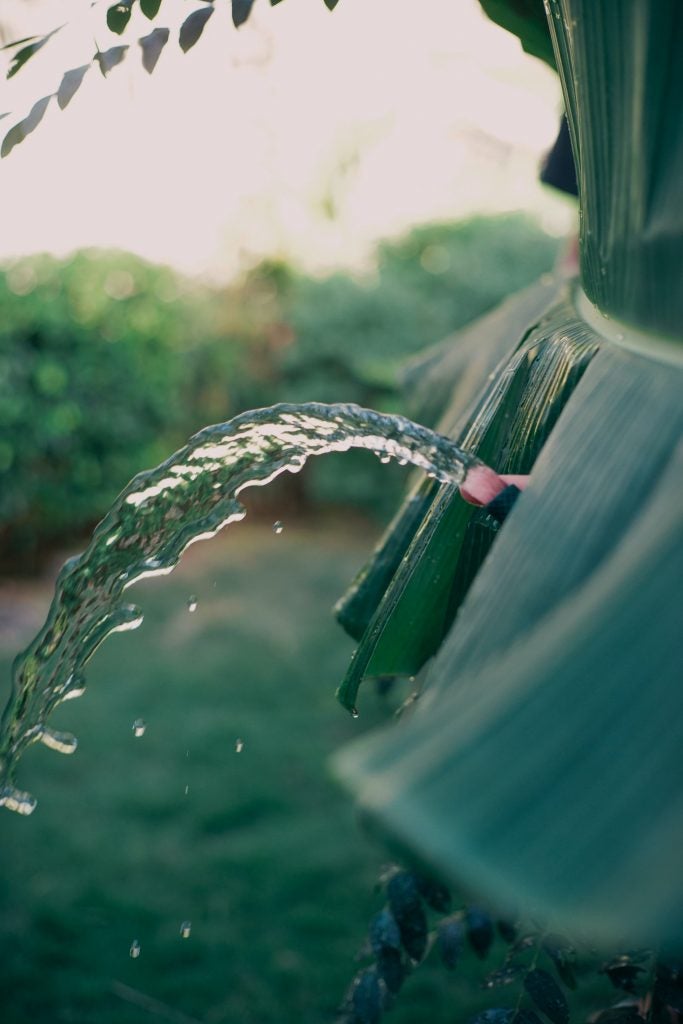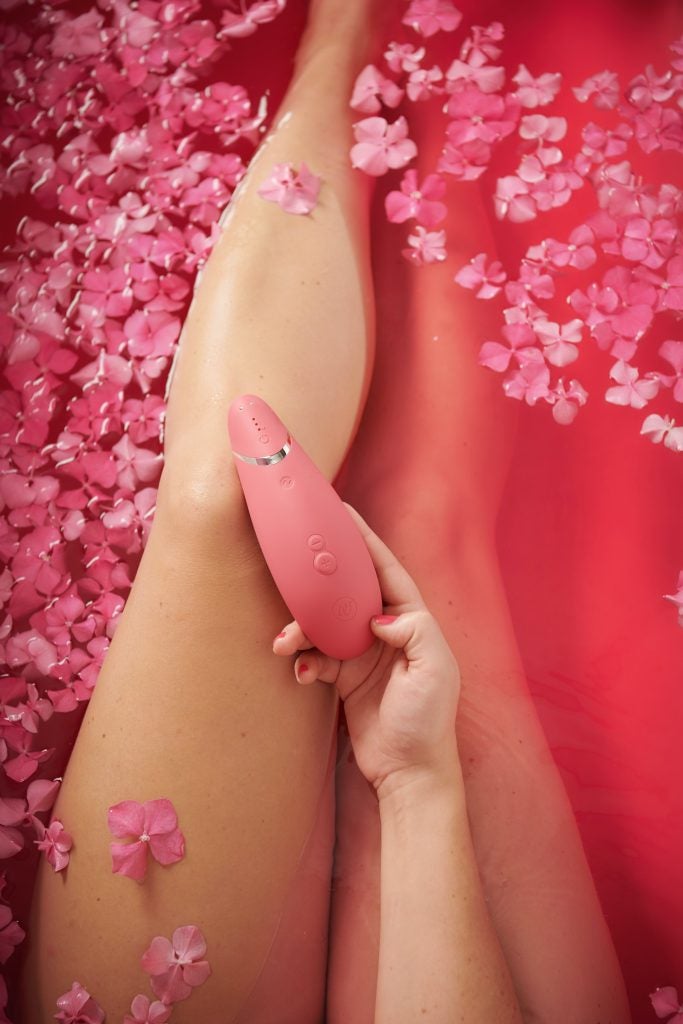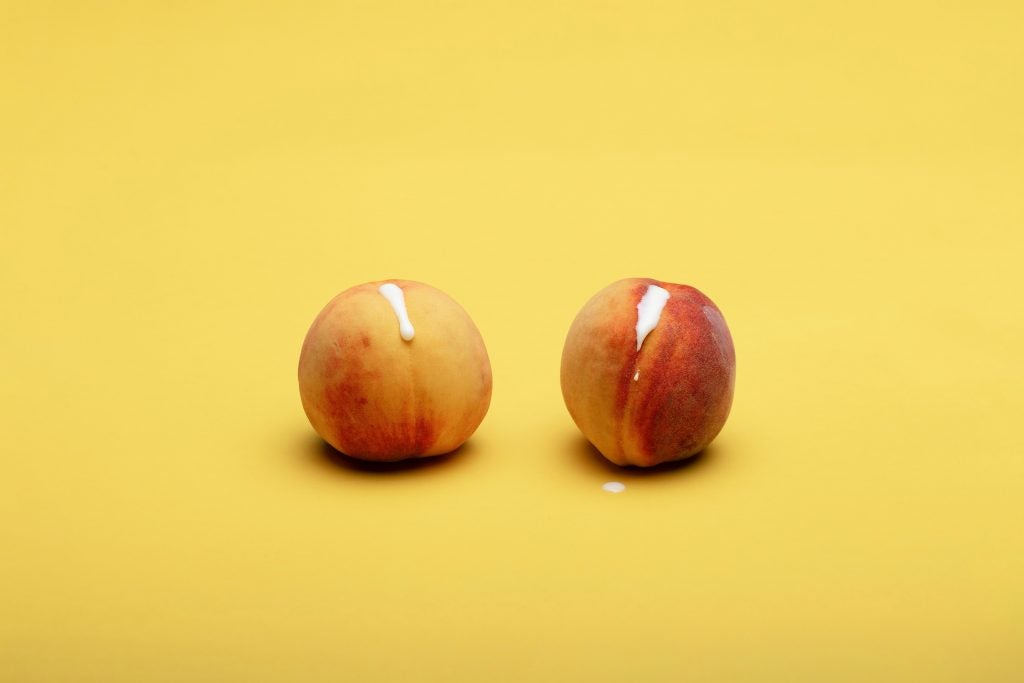
It has been traditionally accepted that while females may experience orgasm, sexual intercourse is centered on the ejaculation of a male. However, modern researchers have built upon the experiments of historically well-known sex researchers to explain the phenomenon known as female ejaculation. These recent studies have shown that women, too, can and have experienced ejaculation. This discovery is changing pre-conceived ideas about the female sexual response cycle, and debunking the notion that males and females are “sexual opposites.”
Female ejaculation refers to the expulsion of fluid from a female’s urethra during sexual arousal or orgasm. The amount of “ejaculate” can vary, ranging from only a few milliliters to a large enough volume to make a woman believe she has urinated. Female ejaculation is so controversial that is has been banned from porn in the United Kingdom, and remains somewhat taboo in the United States.1
Table of Contents
Historical References to Female Ejaculation
Historical data indicates that female ejaculation has been a topic of interest for thousands of years, there are even records of Aristotle’s curiosity about the expulsion of liquid from a female’s urethra during sexual activity.1 German gynecologist Ernest Gräfenburg, known for discovering the erogenous zone called the Gräfenburg spot (or G-spot), observed that the expulsion of fluid from the urethra during sexual arousal was not for lubrication purposes because it most often occurred in conjunction with orgasm.2 Gräfenburg’s discovery is important to understanding the female sexual response cycle, but many experts remained unconvinced. Other pioneer sex researchers Masters and Johnson regarded the idea of female ejaculation as a myth. They only reported receiving “a handful” of female subjects claiming to have experienced an expulsion of fluid at the time of orgasm, and thus concluded that these women had issues of urinary incontinence.3 In fact, for many years it was recommended that women who were experiencing an expulsion of fluid from the urethra during sexual arousal or orgasm should avoid the sexual acts that caused ejaculation or undergo surgery to fix urinary incontinence.4
The phenomenon was explored in detail in the 1980s by researchers including Frank Addiego, Beverly Whipple, and Edwin Belzer, who related female ejaculation to the G-spot when they found that if the erogenous vaginal zone was stimulated, their female subjects could release small volumes of fluid from the urethra.5
Origin of Ejaculate

Researchers are exploring the idea of female ejaculation as a two-part phenomenon, involving a “squirting fluid” which consists of a large volume of colorless, odorless liquid, along with an “ejaculate” that appears thick and milky, similar to male semen. The squirting fluid usually is compared closely with urine, as it has been found to contain urinary markers such as urea and creatinine.6 However, the ejaculate fluid contains prostatic acid phosphatase (PSA), along with other analogues of male semen. PSA is an enzyme usually found in male semen that aids in sperm mobility. Researchers have found that there are significantly higher levels of PSA in a female’s ejaculate fluid than there is in the same female’s urine samples (taken when she is not aroused).4 Female ejaculate also typically contains higher levels of fructose than urine samples. Fructose in male semen serves as an energy source for sperm. Some experts think that the presence of PSA and fructose in female ejaculate, while in much smaller concentrations than in male semen, is meant for added stability of sperm to increase the success of pregnancy. Unfortunately, there are some problems with this theory, including the fact that ejaculate is most often accompanied by urine, which can kill sperm. It is also not physiologically convenient for PSA and fructose to travel from the urethra into the vagina where sperm would ideally be located.7
In a recent study published in 2014, French gynecologist Samuel Salama was the first to use ultrasound technology to examine the female sexual response. He first confirmed that the bladder was empty before sexual arousal, then allowed the women in his study to sexually stimulate themselves in whatever way they chose. Ultrasounds taken just before climax show that the bladder had filled with fluid during arousal. An ultrasound taken after orgasm and ejaculation revealed that the bladder was empty again. This experiment confirmed that the reported ejaculate accumulates in the bladder during arousal, which explains its similarities to urine.1
The Female Prostate
The most current explanation for the origin of PSA and fructose in females is a series of glands called Skene’s glands, also known as paraurethral glands, and Garter’s ducts. These glands are located on the anterior wall of the vagina, in the same area as the G-spot, and when stimulated they secrete the components of female ejaculate fluid into the urethra.4 Because the series of ducts and glands surrounding the female urethra is similar to the male prostate, researchers are calling this area the “female prostate”. The male and female prostates are formed from similar bodily tissues and have comparable secretions (such as PSA), although the female prostate is much smaller than the male prostate, and is less prone to disease. The female prostatic secretions seem to begin with the onset of puberty and change in women after menopause, which indicates that the organ may be hormone-controlled.4
The existence of a female prostate is relevant to female ejaculation, but doesn’t receive much attention in the medical community because further research is needed to determine its physiological purpose. Some researchers are skeptical about the relationship between the female prostate and female ejaculation due to the fact that not all women regularly experience ejaculation, and that PSA may not be found in the ejaculate of every female that does experience it. It has been suggested that all women could be able to produce PSA, but some don’t secrete it regularly. This may have to do with variation in size or shape of the so-called female prostate, or that some women may not have it at all.1 Further research is needed to fully identify and understand the function of the Gräfenburg spot and determine whether or not it is related to the female prostate or female ejaculation.4
Prevalence and Experience of Ejaculation in Women

Because female ejaculation is often considered private, it is difficult to find large enough numbers of women to participate in studies to accurately assess the prevalence of women who experience it. There have been no large-scale studies regarding female ejaculation. Some questionnaire surveys suggest that 40 to 54% of women have at some time experienced expulsion of fluid from the urethra when sexually exited. In a study of 233 women, 14% said that they had experienced ejaculation with all or most orgasms and 54% said that they had experienced ejaculation at least once.3 Examination of pre-orgasmic and post-orgasmic urine in both women who could and could not ejaculate shows that PSA values were higher in the post-orgasmic samples than in the pre-orgasmic samples for all women. Researchers concluded that all women may create an ejaculate fluid, but some women do not expel it, rather it returns back through the urethra and into the bladder. Many women report experiencing an ejaculation with each orgasm during multiple-orgasm instances. However, not all women experience ejaculation at the time of orgasm; sometimes women ejaculate earlier in the arousal cycle. Most women report that ejaculation is not the climax of their sexual encounter, suggesting that ejaculation should be considered independent from orgasm and not as a type of orgasm.3
Studying female ejaculation and making generalizations is difficult because there are many different ejaculation experiences from woman to woman, as proven by a 2009 study in which 13 women were asked about their encounters with female ejaculation. Each of the women reported having their first experiences of ejaculation at various times in their life, ranging from their late teens to early fifties.3 The age of first ejaculation could be determined by physiological changes that occur at that age, such as the onset of puberty, or having a child. One’s feelings of personal safety and comfort and the nature of the sexual encounter could also be responsible for the onset of ejaculation. Some women experience variations in both their ability to ejaculate and the amount of fluid expelled depending on their level of arousal and the condition of their body at the time of sexual activity. Three respondents even stated that ejaculation patterns changed with their menstrual cycle, reporting that ejaculation was most likely to occur after ovulation and before menstruation. Some respondents also reported different types of sexual stimulation that led to ejaculation at orgasm. While a number of the women experienced ejaculation as a result of G-spot stimulation, some claimed that simultaneous clitoral stimulation or clitoral stimulation alone could cause them to ejaculate. Regardless of the type of sexual activity required, the women as a whole reported that they needed to be significantly relaxed, comfortable, and very aroused in order to experience orgasms and ejaculations.3
Also unique to each woman is the way that her experiences of ejaculation affect her sexuality and relationships. A 2009 study found that the reactions of respondents to initial ejaculation could be grouped into two categories: humiliation and shame, and exploration and wonder, with some women experiencing mixtures of the two. Most, but not all of the women who experienced humiliation and shame felt that way because they had no prior knowledge that it was possible for women to ejaculate. Some women and their partners assumed they had urinated and thus tried to curb their sexual desires or limit the amount of sexual activity they engaged in in order to avoid the embarrassment of it happening again. On the other hand, the women who claimed they experienced exploration and wonder reported that they desired to do it again, experimented with themselves and partners, and even shared the information with friends and family.3
Regardless of their initial reaction, many women eventually come to accept and even appreciate ejaculation. Most often the process of acceptance is aided by positive responses from sexual partners or peers, and discovering that the event is relatively common. All of the 2009 subjects said that they now considered their ability to ejaculate a defining part of their individual sexuality and said that they would “be sad” or “would miss it” if they stopped ejaculating.3 For many women, ejaculation makes them feel that they are special, sexy and desirable. Being comfortable with this aspect of female sexuality can even help a female and her partner enjoy sex more!
There is no doubt that there is still much more research that could be conducted in relation to the topic of female ejaculation. Despite the many advances of research in the past few decades, many unanswered questions remain as far as what causes women to experience this phenomenon and especially how many women actually do. Regardless of the undefined aspects, many sources have evidence that female ejaculation does in fact exist and is becoming an increasingly important part of women’s sexuality as a whole.
Tips for Experimenting with Female Ejaculation

Female ejaculation is most often correlated with stimulation of the G-spot, as this is the area that is thought to contain the “female prostate.” Stimulation of this area either manually or by a penis can produce a feeling of needing to urinate, but further stimulation may lead to a pleasurable feeling, swelling of the area, and orgasm that can be accompanied by fluid emission. Sexual activity that provides stimulation of the G-spot is most successful in making women ejaculate with orgasm. Some good examples of G-spot-stimulating sex positions are woman on top, standing face-to-face, or rear entry (i.e. doggy style), and more can be found in our article entirely dedicated to sex positions! The G-spot can also be stimulated manually and with sex toys by a partner or through masturbation. The amount of ejaculate can occasionally be in large volumes, so some females prefer to have a towel handy just in case. It is also convenient to have sex in the shower or in tiled floor to avoid having to clean the fluid from a more absorbent surface.
Remember that the key to a female experiencing orgasm is that she is relaxed and comfortable with herself and her partner. Those who are so concerned with having an orgasm that they cannot focus on masturbation or having fun with a partner are often not able to successfully reach orgasm. If you are interested in experimenting with female ejaculation, the best advice is to relax, enjoy the process, and don’t become too discouraged if something doesn’t work. It takes many females a long time to discover what kind of sexual stimulation they enjoy most. You may also find that no matter the outcome, it can be enjoyable to try different things and learn something new about your body or your partner’s body.
Check out this interesting video about female ejaculation!
References
- Thompson, Helen. “Female Ejaculation Comes in Two Forms, Scientists Find.” New Scientist. N.p., 17 Jan. 2015. Web. 21 May 2015.
- Korda, J. B., Goldstein, S. W., & Sommer, F. (2010). The History of Female Ejaculation. Journal Of Sexual Medicine, 7(5), 1965-1975. doi:10.1111/j.1743-6109.2010.01720.x
- Gilliland, Amy L. (2009). Women’s experiences of female ejaculation. Sexuality & Culture, 13(3), 121-134.
- Zaviacic, M., Whipple, B. “Update on the Female Prostate and the Phenomenon of Female Ejaculation.” Journal of Sex Research 30.2 (1993): 148-151. JSTOR. Web. 21 May 2015.
- Addiego, F., Belzer, E. G., Comolli, J., Moger, W., Perry, J. D., & Whipple, B. (1981). Female ejaculation: A case study. Journal of Sex Research, 17(1), 13-21.
- Rubio-Casillas, A., & Jannini, E. A. (2011). New Insights from One Case of Female Ejaculation. Journal Of Sexual Medicine, 8(12), 3500-3504. doi:10.1111/j.1743-6109.2011.02472.x
- Zaviacic, M., et al. “Concentrations of Fructose in Female Ejaculate and Urine: A Comparative Biochemical Study.” Journal of Sex Research 24.1 (1988): 319-325. JSTOR. Web. 21 May 2015.
Last Updated 28 May 2015.
